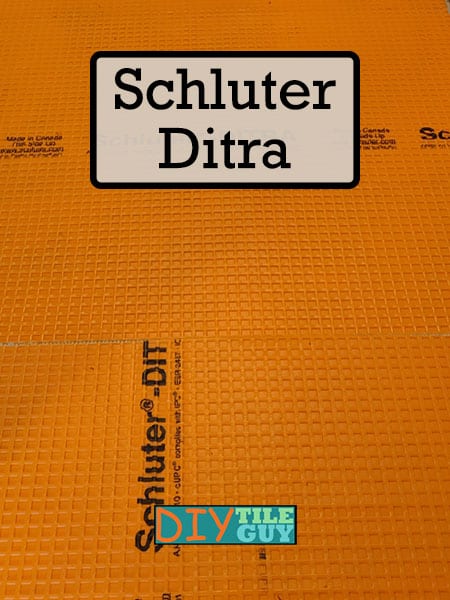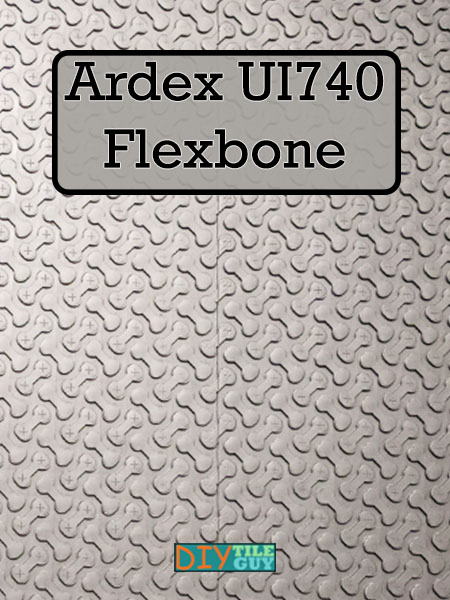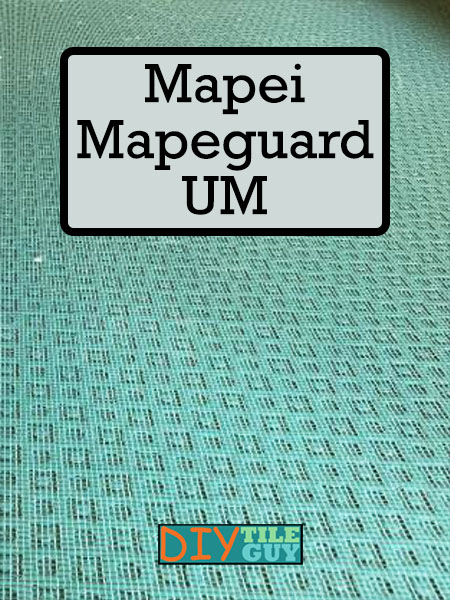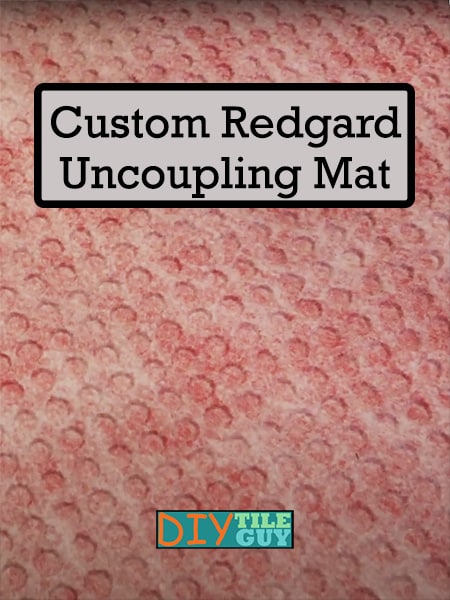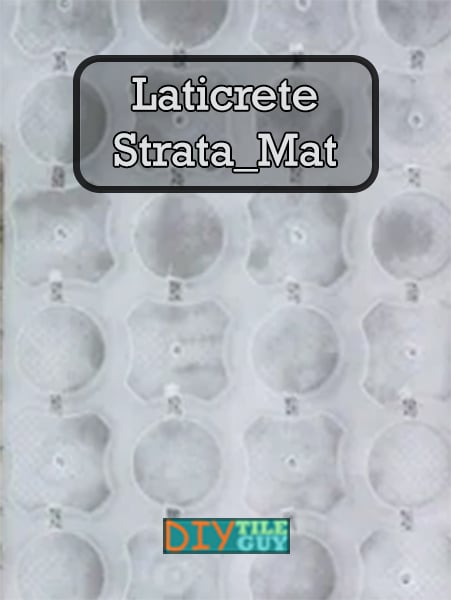I love Schluter Ditra and would recommend it to anyone. However, there are many alternatives to Ditra that have entered the market and they are worthy of consideration.
There are many reasons to consider an alternative to Ditra, which could be:
- Local availability of a particular brand
- Price
- System warranty with other components you are using
- Individual features
This post will examine Schluter Ditra and four Ditra competitors. These are all reputable companies that make quality products and respect tile industry standards.
- This post contains affiliate links. The site owner may earn a commission should you click on an affiliate link and make a purchase. Read more
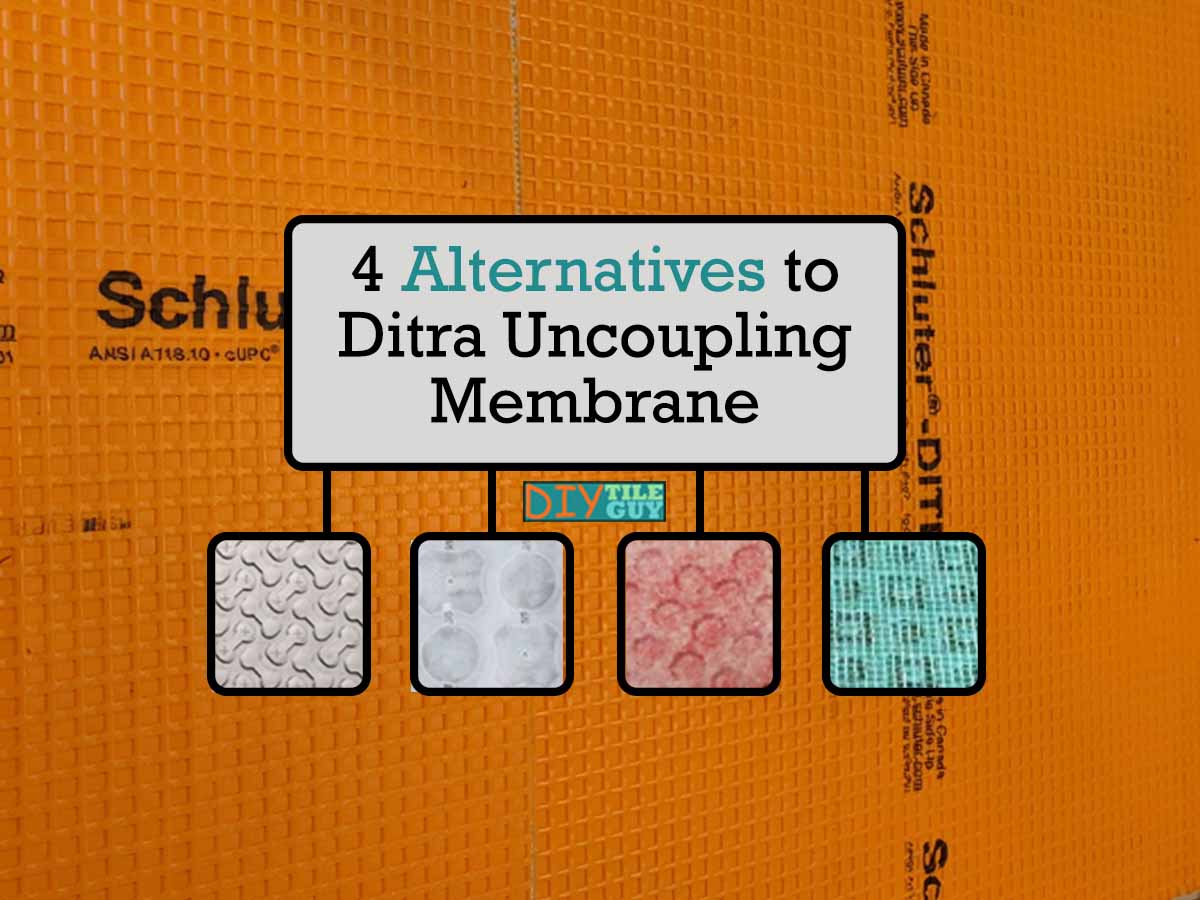
Estimated reading time: 8 minutes
The 5 Uncoupling Membranes Options
The five membranes being compared are:
- Schluter Ditra
- Ardex UI 740 Flexbone
- Mapei Mapeguard UM
- Custom Redgard Uncoupling Mat
- Laticrete Strata_Mat
These products are NOT RANKED but, instead, are listed in alphabetical order.
The Original Uncoupling Membrane
First, we’ll start with the original.
Schluter Ditra
Originally launched in 1987, Ditra was truly an original as there were no alternatives. In fact, it helped to usher in a sweeping change in the tile industry. Uncoupling membranes are now commonplace as a tile underlayment.
Ditra is a plastic sheet membrane that is 1/8-inch thick and has a square dimple pattern on the surface. The dimples create a dovetail system which are wider at the bottom and narrower at the top.
Mortar fills the dimple and, once dry, is locked in the cavity.
Additionally, the underside of Ditra has fleece attached to it which gets embedded into a layer of thinset.
Schluter Systems touts four characteristics that form the core function of their membrane: Uncoupling, Waterproofing, Vapor Management, and Load Distribution.
Ditra, created in Germany, is one meter wide which converts to 39 3/8 inches. It comes in three roll sizes: 54 sq. ft; 150 sq. ft; and 323 sq. ft. It also comes in a 1/4-inch thick version called Ditra XL, a heated version called DITRA-HEAT and DITRA-HEAT DUO, and finally, a peel & stick option, DITRA-HEAT-PS, which requires no mortar.
My thoughts:
In 2022, Schluter launched a new version called Ditra 2.0 with larger squares and more flexibility to the membrane.
Some of the complaints about the previous version of Ditra were that the dimples would crush down sometimes when working on it and that the plastic roll had a bit too much “memory” where the edges might try to peel up rather than stay unrolled.
These issues have largely been fixed with the new membrane. Further, the Ditra 2.0 is easier to fill with thinset and less likely to trap air in the recesses.
The old stuff didn’t take pencil and chalk lines very well and this hasn’t changed with the new version.
You might want to check out my post on Ditra installation if you are considering this product.
4 Alternatives to Ditra
Perhaps you want to explore your options beyond Ditra. Here are four uncoupling membrane alternatives to Ditra.
Ardex UI 740 Flexbone
Flexbone is Ardex’s alternative to Ditra. Rather than squares, Flexbone uses a long, rounder shape that looks like a bone you might see in a cartoon.
The bone shapes sort of weave and overlap on the membrane which doesn’t allow for any long channels to run through the length of the membrane. This is by design, and Ardex claims this creates more tensile bond strength.
Additionally, Flexbone’s ‘bones’ are wider at the top to mechanically lock in thinset mortar. It also has a fleece layer attached to the bottom which attaches the membrane to the floor when embedded into a thinset layer.
Further, this Ditra alternative is waterproof and now has ventilation channels that can allow for vapor equalization. Typically, this means that it can be installed over new concrete but Ardex doesn’t specifically state that in their data sheet.
Flexbone UI 740 is 39 3/8 inches wide (1 meter) and comes in both a 54 sq. ft and 215 sq. ft roll. Additionally, you can purchase Flexbone in a heated version, Flexbone Heat, and a floating version, UI 720 Flexbone, that doesn’t attach to the floor.
My thoughts:
Flexbone is a nice membrane to use. I don’t know how much stock to put into the interlocking bone system but the lack of roll memory is amongst the best in class and the bones don’t crush like some other products.
Mapei Mapeguard UM
This Ditra competitor would appear to be a fairly normal-looking membrane, except it has netting over the entire top.
Mapeguard is still a plastic membrane with fleece attached to the underside. It has squarish and circular dovetail dimples. But then it has a screen-type material over the top.
The screen material helps to protect the middle plastic layer from being crushed while being worked on.
Mapeguard UM is a waterproof membrane that is 1 meter wide and comes in both 54 sq. ft and 323 sq. ft. rolls. Additionally, there is Mapeheat for heated floors.
My thoughts:
This is a nice Ditra alternative that lays flat on the floor and the dimples fill nicely.
However, I would have thought that the top mesh layer would allow for a smaller minimum tile size. But, Mapei still limits the minimum size to 2×2 inches which is the same as the others on this list.
Custom Redgard Uncoupling Mat
Redgard mat looks the most different of the five Ditra competitors mentioned in this post. It feels more like carpet than a plastic membrane.
While it still has geometric dimples, Redgard doesn’t rely on a dovetail design like its competitors. Instead, it has fleece-like fibers on both the top and bottom sides, which lock in the mortar.
Additionally, Redgard is the only one on this list that is an ANSI A118.12 crack isolation membrane. Are you curious what the difference is between crack-isolation, uncoupling, and anti-fracture?
So, if you are using it over concrete with cracks, then this may be the better choice if you want to use an uncoupling membrane in that situation.
Redgard Uncoupling Mat is a 39 3/8 inch wide waterproof membrane that comes in both 54 sq. ft and 323 sq. ft. rolls.
However, there’s no 1/4 inch thick version so this may not be a good choice if you are trying to match heights for a tile-to-wood transition.
My thoughts:
Redgard Uncoupling is a joy to work off of as it feels like carpet. You need to be careful not to let debris like sawdust get into it because the top fleece layer will trap it right in.
Additionally, it’s rolled up tighter than Ditra and the others, so the end of the roll can be deformed. But, your pencil lines show up easily on it.
Laticrete Strata_Mat
Stratamat looks similar to other uncoupling membranes, but it has some unique qualities.
Similar to others, it has square-ish dimples that lock in mortar. Stratamat is both white and translucent, which allows you to visibly see when it’s embedded into mortar. The white color also allows chalk and pencil lines to be visible.
Another quirk of this Ditra competitor is that the mat has ventilation holes, which allow the mortar to dry more quickly.
I don’t want to get into the whole modified vs unmodified argument, but this is Laticrete’s way of ensuring that modified mortar will be able to dry underneath the tile.
Another advantage of the air channels is that they don’t trap air under the membrane. This makes it easier to embed, and it’s not crucial that you start rolling it from the center of the mat. The air can escape through the ventilation holes or the edges of the membrane.
The obvious consequence of ventillation holes is that the membrane is not waterproof. If you require waterproofing, then you may be better off looking at either Ditra or another Ditra alternative.
Strata_mat is 45 inches wide and comes in 150 sq. ft and 323 sq. ft rolls. Also available, is Strata_mat XT at 5/16 inch thickness and Strata_Heat for heated tile floors.
My thoughts:
Strata_mat has some nice qualities to it. I do like the translucent aspect of it. However, the air channels can be uncomfortable on your hands because they poke through.
Personally, I don’t see the 45-inch width as either an advantage nor a disadvantage. It would depend on how it works out for the width of your room.
Comparison Table for Ditra and 4 Ditra Alternative Uncoupling Membranes
*See comments above for clarification
Conclusion
That’s the low-down on five different uncoupling membranes and how they compare to one another. Ask your questions in the comments.
